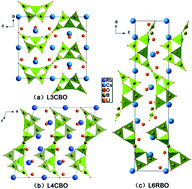p–(p,π*) interaction mechanism revealing and accordingly designed new member in deep-ultraviolet NLO borates LinMn−1B2n−1O4n−2 (M = Cs/Rb, n = 3, 4, 6)†
Abstract
Exploration on the compounds in the complex alkali metal borate system had resulted in the discovery of a class of deep-ultraviolet second-order nonlinear optical (NLO) materials, including Li3Cs2B5O10 (L3CBO), Li4Cs3B7O14 (L4CBO), and Li6Rb5B11O22 (L6RBO), which can be reduced to a general formula of LinMn−1B2n−1O4n−2 (M = Cs/Rb, n = 3, 4, 6). All of the three crystals exhibit a short UV cutoff edge (below 190 nm) and share a class of topologically similar BO groups interconnected by LiOn (n = 4, 5), Rb/CsOn (n = 8, 9, 10). The mechanism of NLO properties of this class of crystals was studied using band-resolved and SHG-density methods based on the first-principles theory. The results reveal that the “charge-transfer excitation” from the non-bonding 2p occupied states of O atoms to the π* and 2p unoccupied states of the BO3 substructure in BO groups is the key mechanism of NLO properties of this material family. Through systematic analyses on the relationship between crystal structure and NLO effects, a new crystal, Li4Rb3B7O14, was designed and subsequently synthesized through solid state reaction, which is isomorphic with Li4Cs3B7O14 and exhibits a short UV cutoff edge (below 190 nm) and a SHG response of 2/3 × KDP.


 Please wait while we load your content...
Please wait while we load your content...